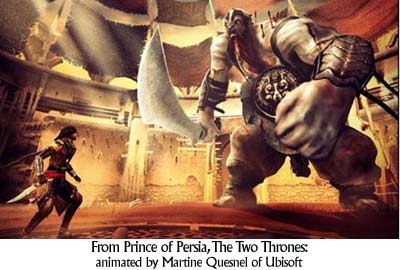Video Game Animation
Pegboards vs Polygons:
Animating for Video Games
By: Mark Garabedian on behalf of Animation Mentor. For more information about Animation Mentor visit www.animationmentor.com.
The venerable art of animating still images has existed in some form or another since the 1800s. Today, however, new evolutionary offshoots of the artform make the industry more diverse than ever. Video Games in particular, offer a variety of opportunities and restrictions not found in previous forms of animation.
Regardless of the platform, video games offer a cornucopia of rich animation, be it in the Full Motion Video cut-scenes or the abundant in-game engine animations. FMV can be either hand drawn or CG, and is generated in much the same way one would produce content for film or video. With limited or non-existent user input, FMV sequences are mostly employed for narrative purposes. The in-game engine animations are the real source of the mediums' potential. It is here that a talented artist is able to tell a story using body language and limited graphics. "How a character walks (e.g. slouching sadly or bouncing happily) is telling the character's story," points out Sam Yip.
Sam Yip is a senior animator at Disney Interactive. His portfolio includes such games as "Pirates of the Caribbean Online," "Saints Row," and "Golden Eye: Rogue Agent." A fan of both traditional animation and recent interactive mediums, he believes the major distinction between games and film lies within the mediums' objectives. "The goal of [film] animation is to serve a story/narrative, and in video games, the animation's goal is to serve the game play, so the game player can create his own story."
While voice over and scripted story sequences are common place in today's games, the artist's task is to inject as much personality into the player's avatar as possible. Yip reminds us that "Video game animations will have a lot of body movements such as running, walking, swinging a sword, and a lot of them will be cycled." This is where many genre restrictions come into play. Since a player commands the character, an artist is given the task of creating believable movements that can be transitioned to at a moment's notice. Much of this affects how anticipation is handled.
 Anticipation, in both traditional and interactive animation, is how a character physically prepares for a movement. This is a simple process in film and television, since the animator has the storyboard and can prepare accordingly. In games, an animator will be asked to strike a fine balance between instantaneous character response and believable movement.
Anticipation, in both traditional and interactive animation, is how a character physically prepares for a movement. This is a simple process in film and television, since the animator has the storyboard and can prepare accordingly. In games, an animator will be asked to strike a fine balance between instantaneous character response and believable movement.Technological limitations further challenge this process, such as an engine's frame-rate. "The anticipations in video game animations could be just a few frames," reiterates Yip, "if the frame rate is low and those few frames are skipped, then the player will not see the anticipation at all, which lessens the impact and believability of the animation." This can be overcome by creative planning, and the abbreviation of movements.
Modern games use diverse animation techniques and styles, though the majority achieve 3D through Maya and 3DS Max software. This opens up new considerations. In traditional animation, the focus is placed on the action within the frame, yet video games allow us to view the events from nearly any angle, thus requiring a universal approach and wider attention to detail.
As with theatrical CG, the choice between MoCap and Keyframe exists. Some games require a cartoony style that only time-consuming keyed animation can reproduce, while others benefit from the tangible realism of MoCap, though an extensive cleanup process may be necessary.
Video game animation offers a plethora of exciting opportunities and hurtles. For those involved, this digital playground offers a rich and rewarding experience, creating animation that connects to the audience on a more personal level then ever before. (Most sudios also mostly hire full time, rather than by contract!) For those interested in pursuing a career in this field, Sam recommends, "Find your passion, and just do it."
Mark Garabedian has been an animation aficionado from a young age, having worked his first job mowing lawns in Massachusetts to buy cels. An Emerson College alum, Mark is now a freelance animation writer and member of the Animation Guild, residing in Burbank, California.

.gif)
.gif)


0 Responses So Far:
Post a Comment